Culture and History
There is a permanent exhibition of relics and liturgical objects that were once used in the coronation ceremonies, as well as a list on the cathedral wall of the 19 monarchs – ten kings, one queen and eight consorts – who were crowned here.
There is plenty to occupy the English-speaking traveller who appreciates Bratislava’s hipster vibe but may lack the stamina to keep up with the youngsters. Although the city rocks with a vibrant nightclub and bar scene that is perhaps more in keeping with the younger generation, there are ample opportunities for travellers of a “certain age” who possess more cultivated tastes to savour superb art exhibitions, enjoy sophisticated wine tastings, and delight in world-class music and ballet performances.
A stop at the Tourist Information Centre on the Klobúčnicka Street, close to the Main Square, is a good starting point. The staff speaks English and are happy to answers any questions and provide you with helpful brochures in English that describe the city’s attractions, suggested tours, itineraries as well as its history.
The single most significant period in Bratislava’s history was from 1563-1830, when it became the coronation city of the Hungarian Kingdom. Even today, St Martin’s Cathedral still has a 150kg-gilded copy of St Stephen’s crown (the Holy Crown of Hungary) at the top of its cathedral tower.
After the era of coronations in Bratislava ended, the crown jewels were moved from the city. At the moment, the original crown is in Hungary, while Bratislava has only a copy.
Today, the St.Martin’s gothic cathedral of is one of the most popular sights on the Bratislava tourist trail and contains numerous fascinating artefacts in its main building and catacombs. There is a permanent exhibition of relics and liturgical objects that were once used in the coronation ceremonies, as well as a list on the cathedral wall of the 19 monarchs – ten kings, one queen and eight consorts – who were crowned here.
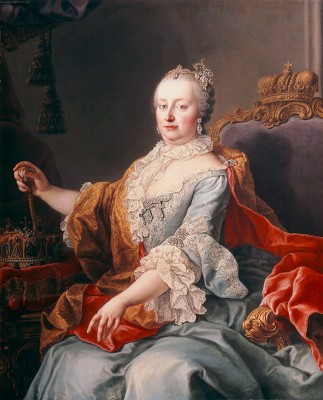
It might be a good idea to take the Bratislava City Tour, a small bus-like conveyance (they call it the “Oldtimer”) that is small enough to wend its way slowly through the Old Town’s narrow streets. A pair of disposable earphones with a guided tour in several languages complements the experience of making you feel at home in this very manageable city. One of the stops during the tour is the castle. After Maria Theresa came to the throne in the 18th century, it was rebuilt into a stately baroque residence. Her son-in-law Albert of Saxe-Teschen (who married Maria Theresa’s favourite daughter Marie Christine) added a family gallery. The large areas of the yard behind and around the castle were also cultivated into terraces, French gardens, orangeries and summer and winter riding schools and stables. Maria Theresa’s influence over the empire was largely positive. Bratislava, in particular, underwent a period of significant economic and social growth.
The City History Museum in the Old Town Hall showcases the lives of Bratislava residents from pre-history to the present day. If you’re fit, climb to the top of the tower for a panoramic view of the Main square and the Old Town; it is worth the effort and adds an aerial view to the on-the-ground Bratislava City Tour.
Discover the different architectural styles as well as the various states of reconstruction taking place in the city. It is not unusual to hear stories of treasures discovered during these reconstructions throughout the ages. One such treasure can be viewed at the Primate’s Palace. The archbishop sold the building to the town in 1903, but luckily, the agreement included the building and anything found in it—and what was found behind the walls were six priceless Mortlake Tapestries from the 1630’s made in Mortlake, England which depict the love story of Leander and Hero. The Primate’s Palace also contains the Hall of Mirrors, where the Peace of Pressburg Treaty was signed ending the era of the Holy Roman Empire. Peer into the classicist-style Chapel of St. Ladislaus from a second floor gallery. The Chapel was established in 1780 and a mass is still held here every Sunday.
Another art venue, the Pálffy Palace, is part of the Bratislava City Gallery and the arts it contains spans several centuries from Gothic painting and sculpture to 20th century Central European Painting and Sculpture and Slovak visual art. On the top floor check out the two permanent installations; Alex Mlynarcik’s “Villa of Mysteries” where visitors walk through red curtains into a rather sexual experience of nude photographs coated in red and Matej Kren’s “Passage,” another visual treat that uses mirrors and almost 15,000 books to convey the illusion of the space and depth of human knowledge.
The Slovak National Gallery acknowledges a “challenging reconstruction” by frankly asking visitors, “How permanent is a permanent exhibition?” Responding to the reduction of exhibit space for its permanent collection during a remodelling, the Gallery’s curators have selected the most significant works from its storehouse of Gothic and Baroque paintings and sculptures. In a switch from the conventional style of exhibiting, the artworks are grouped by theme rather than by date.
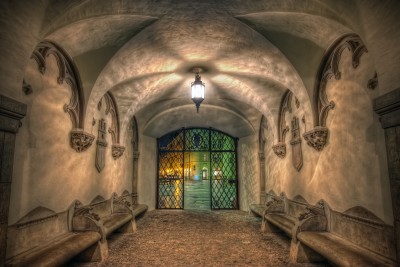 Two fairly new private museums add to the city’s burgeoning art scene. Opened in October 2012, the Nedbalka Gallery’s four floors contain over 600 works of art including painting, prints, and statues. Its circular four-storey structure is said to resemble the Guggenheim in New York. The exhibit space is sparse and intimate allowing the visitor to fully concentrate on Slovak fine art from the late 19th to early 20th century.
Two fairly new private museums add to the city’s burgeoning art scene. Opened in October 2012, the Nedbalka Gallery’s four floors contain over 600 works of art including painting, prints, and statues. Its circular four-storey structure is said to resemble the Guggenheim in New York. The exhibit space is sparse and intimate allowing the visitor to fully concentrate on Slovak fine art from the late 19th to early 20th century.
Don’t expect bored museum guards here; the staff, while unobtrusive, will engage and share their enthusiasm about the art if invited. There is a family-like atmosphere among the staff that appears to take pride in being part of a new enterprise. Browsing is encouraged and the cup of coffee thoughtfully included in the entrance fee rounds out the relaxing atmosphere.
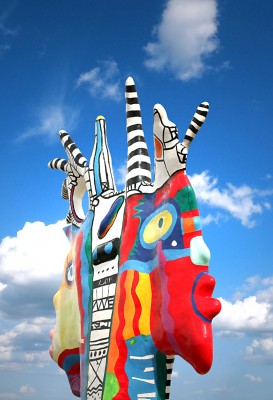
An experience of a different sort awaits the art lover who ventures 20 kilometres south of Bratislava. The Danubiana Meulensteen Art Museum offers a reward to those willing to make the trek by car, bus or boat. First opened in 2000, with a new wing added in September 2014, Danubiana is located on the Danube River on a peninsula bordering Austria, Slovakia and Hungry. The museum’s romantic and natural setting enhances the art appreciation experience. The collection encompasses the work of Slovak as well as European modern artists.
There is an extensive collection inside as well as outside: the curators incorporated the museum’s unique location on the water with spacious galleries inside containing paintings and sculptures that artfully blend with the river and sculptures outside. At any given moment, the visitor inside observing the art may turn to the Danube outside and find 20 swans observing him. Steps outside the museum lead to the roof where more sculptures await.
After a dose of arts, one may well want a drink, and Bratislava offers a rather special treat for wine lovers. The cellar of the Museum of Viticulture at Apponyiho Palace (part of the City of Bratislava Museum in Old Town Hall) contains the 100 best Slovak wines (judged every year from over 8,400 entries). Visitors can opt for several programmes, but true wine connoisseurs will most likely enjoy to sample 80 out of 100 top wines in 100 minutes at the cost of only 19 euros.
The wine connected directly to Bratislava is Frankovka (Blaufränkisch) red wine produced in Rača (a part of the city), which had a royal seal of approval, bestowed by the Hungarian queen Maria Theresa in 1767. She was reputedly enchanted by its taste and quality and deemed it suitable to be served at the imperial table. It is good to check whether Frankovka from Rača is among the top 100 Slovak wines and if so, you may taste the queen’s favourite wine!
While savouring fine art and drinking fine wine doesn’t require language abilities, other often overlooked cultural experiences that translate well for English-speaking tourists are ballet and opera. Slovakia enjoys a rich history of performing arts with very reasonably priced ballet, opera and classical music productions.
When walking through the Old Town, visitors will no doubt notice a series of memorial plaques on the walls of the various palaces, often displaying Bratislava’s links to a rich history of classical music. Some of history’s most significant composers are known to have played their sonatas at the homes of Bratislava’s noble families. A six-year-old Wolfgang Amadeus Mozart is believed to have given a concert on Ventúrska Street in 1762. In 1820, a nine-year-old Franz Liszt performed in what is now the University Library. Both visited Bratislava at the beginning of their illustrious careers and dazzled local audiences. Liszt became a regular visitor to Bratislava.
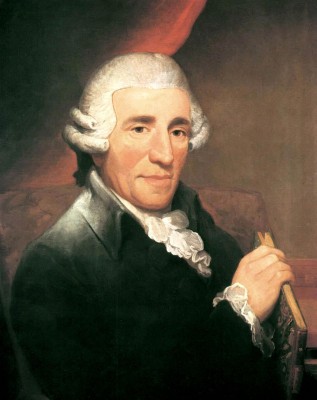
During the 18th century, the Austrian classicist composer Joseph Haydn worked as a Kapellmeister (in charge of music) for Prince Nikolaus I Esterházy in one of Esterházy’s palaces on Kapitulská Street. (The ruins of the palace still stand.) In 1772, Haydn conducted the wedding ball of Queen Maria Theresa’s daughter in Grassalkovich Palace, today’s seat of the Slovak President.
Esterházy also hosted Haydn and Mozart’s student, Ludwig van Beethoven, who visited Bratislava several times and had many friends here. Bratislava also boasts its own home-grown talent to match this group of successful visiting musicians: Johann Nepomuk Hummel, who was born in 1778 in Nedbalova Street in Bratislava, where you can find his museum today. Hummel was a roommate of Mozart and at the time was equally well-known as his friend. Forty-eight years after Hummel’s death, the Russian pianist and composer Anton Rubinstein played a memorable concert in Bratislava to collect money for Hummel’s memorial.
The Slovak National Theatre was born in 1920, shortly after Czechoslovakia was established. There are two venues to choose from when booking ballet or opera tickets. The historical “old” building (built in neo-classicist style in 1884-1886) on Hviezdoslavovo Square and the so-called “new building” located on the banks of the Danube (built in 2007). The companies are first-rate as evidenced by sell-out crowds that include nearby Austrians, who attend by the busload joining the Slovaks and others.
It is said that to experience a foreign country fully, one must venture out of the city and into the countryside, to explore where authentic culture still exists. But those consigned to the city need not miss out: it is also possible to experience traditional Slovakia without ever leaving the capital.
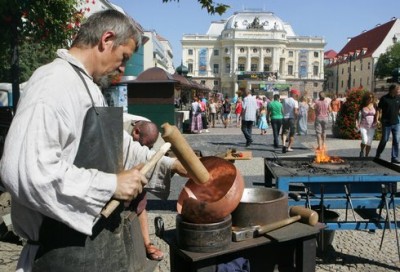
The Centre for Folk Art Production’s ÚĽUV Gallery on the Obchodná Street is ground zero for anyone interested in traditional Slovak culture. The gallery houses temporary exhibitions of genuine, historical Slovak artefacts, as well as reproductions by contemporary artists. Both decorative and functional, the items reflect various facets of rural Slovak life, from intricately embroidered garments and headdresses, to ceramic, majolica wine jugs and flasks. In the courtyard behind the gallery is the Regional Centre of Crafts, in which there are several workshops where people of all ages can learn pottery, woodcarving, tinkering, and weaving, from artisans eager to pass on their skills.
ÚĽUV’s two shops sell faithful reproductions of Slovak folk artefacts, including traditional instruments like the fujara, a five-foot long, wooden fipple flute, popularised by shepherds in central Slovakia. The shops also sell beautiful, hand-sewn examples of traditional peasant garb, called kroj. Worn regularly in some rural villages up until the 1930s, the outfits feature vibrant colours and beautifully embroidered floral patterns. Each town had its own distinct pattern, and one could tell where a woman came from by looking at her dress.
Traditional kroj-clad dancers, with their fast, intricate footwork and graceful moves, are a point of pride for many Slovaks. Several traditional Slovak dance troupes perform periodically in Bratislava. The popular Lúčnica ensemble has been wowing audiences for more than 60 years with its colourful and exuberant stage productions. SĽUK ensemble put on similarly spirited shows.
While the English speaker may find it challenging to pronounce those tongue-twisting Slovak vowels, there are plenty of activities where no language is needed: just the joy that comes from viewing great art, drinking great wine, and appreciating great performances. Isn’t that truly what life is all about?